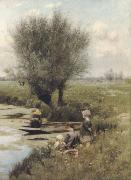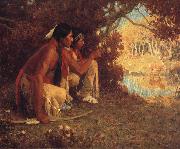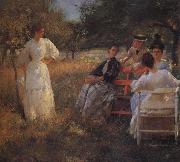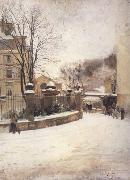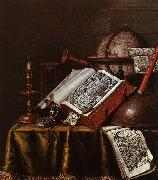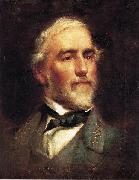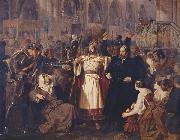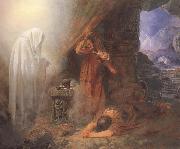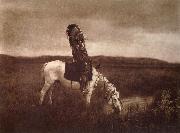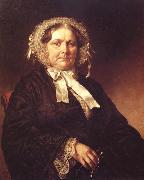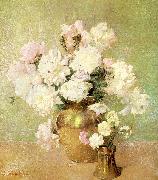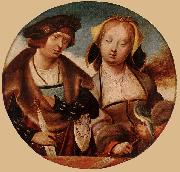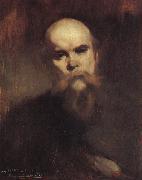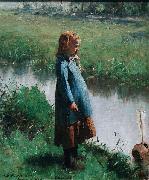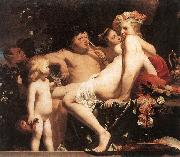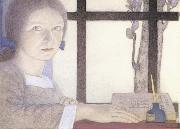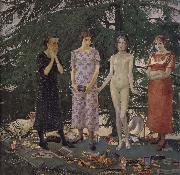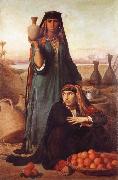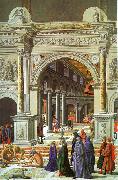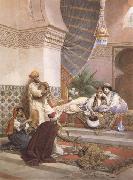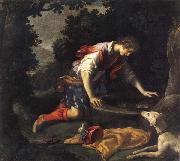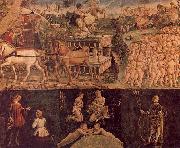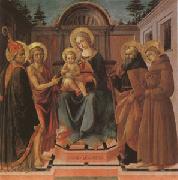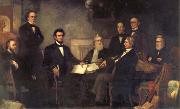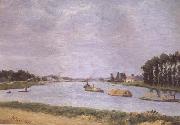|
|
|
|
|
|
 |
Ebenezer Colls
|
|
(1812- 1887 ) - Painter
painted Sailboats in a squall in |
|
 |
Edith Corbet
|
|
(28 December 1846 Goulburn, New South Wales - 1920 Hampstead), was a Victorian landscape painter, having close associations with the Macchiaioli group (also known as the Tuscans or Etruscans), who, in a break with tradition, painted outdoors in order to capture natural light effects and favoured a panoramic format for their paintings.
Edith was born in Goulburn, New South Wales, Australia, the second daughter and fifth child of Henry Edenborough and Margaret Stedman. The Edenborough family came from Leicestershire, but relocated to London, where they became prosperous merchants in hosiery and silk. Henry Edenborough was a sea captain and made several voyages to Australia between 1833 and 1837, deciding to settle there in 1840. He acquired a farm south of Goulburn known as 'Wollogorang' and built "a handsome two-storey brick and stone rubble building notable for its interesting French windows and its impressive outbuildings". This was the family home until 1854 when Henry and Margaret sold the property to John William Chisholm, and returned to England with their family of six children. Henry died in 1855 at Chesham Lodge in Surrey, aged 43. In 1861 the British census records show Edith, 14 years old, living with her widowed mother in Kensington. The 1871 census shows her living with her sister Annie, noted as head of household, at 5 Sheffield Gardens in Kensington, in which year she was exhibiting her work in London.
She married the painter Arthur Murch and moved to Rome where she painted with Giovanni Costa, leader of the Macchiaioli group. In 1876 they both stayed in Venice. Olivia Rossetti Agresti wrote: "Costa had a very high opinion of this artist's gifts and used to remember with pleasure how on that occasion they used to go out together to paint from nature at Fusino" (Agresti, 1904).
Edith Murch frequently exhibited from 1880 to 1890 at the Grosvenor Gallery and the New Gallery. In 1891 she married Matthew Ridley Corbet, one of the Macchiaioli group's leading members, after which she exhibited mainly at the Royal Academy, visiting Italy and living in London for the remainder of her life.
|
|
|
|
|
|
|
|
|
|
|
|
|
|
|
|
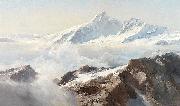 |
Edward Theodore Compton
|
|
(July 29 1849 - March 22 1921) was an English-born, German artist, illustrator and mountain climber. He is well-known for his paintings and drawings of alpine scenery, and as a mountaineer made 300 major ascents including no fewer than 27 first ascents.
Compton was born in Stoke Newington in London, the son of Theodore Compton, an art-loving insurance agent, and grew up in a deeply religious Quaker household. He attended various art schools, including, for a time, the Royal Academy in London, but otherwise he was mainly self-taught in art.
|
|
|
|
 |
Egide Charles Gustave Wappers
|
|
(23 August 1803 Antwerp - 6 December 1874 Paris) is best known as the Belgian painter Gustave Wappers, while his oeuvre is also reckoned Flemish. He signed works by the name Gustaf Wappers.
He studied at the Royal Academy of Fine Arts in Antwerp, and during 1826 in Paris. The Romantic movement with its new ideas about art and politics was astir in France. Wappers was the first Belgian artist to take advantage of this state of affairs, and his first painting, "The Devotion of the Burgomaster of Leiden," appeared at the appropriate moment and had marvellous success in the Brussels Salon during 1830, the year of the Belgian Revolution. While political, this remarkable work revolutionized the direction of Flemish painters.
Episode of the Belgian Revolution of 1830 (1834), Museum of Ancient Art, Brussels.Wappers was invited to the court at Brussels, and was favoured with commissions. In 1832 the city of Antwerp appointed him Professor of Painting. He exhibited his masterpiece, "Episode of the Belgian Revolution of 1830" or rather "Episode of the September Days of 1830 on the Grand Place of Brussels", (Museum of Ancient Art, Brussels) at the Antwerp Salon in 1834. He was subsequently appointed painter to Leopold, King of the Belgians. At the death of Matthieu-Ignace Van Bree in 1839 he was elavated to director of the Antwerp Academy. One of his pupils was Ford Madox Brown; another was the Czech history painter Karel Javůrek.
His works are numerous; some of them in traditional devotional modes ("Christ Entombed"), while others illustrate the Romantic view of history: "Charles I taking leave of his Children", "Charles IX", "Camoens", "Peter the Great at Saardam", and "Boccaccio at the Court of Joanna of Naples".
Louis Philippe gave him a commission to paint a large painting for the gallery at Versailles, "The Defence of Rhodes by the Knights of St John of Jerusalem". He finished the work in 1844, the same year that he received the title of baron from Leopold I.After retiring as director of the Antwerp Academy, he settled in 1853 in Paris, where he died in 1873 - having been one of the most talented flagships of Romanticism in Belgium.
|
|
|
|
|
|
|
|
 |
Emily Carr
|
|
Canadian Expressionist Painter, 1871-1945 |
|
|
|
 |
Ernest Crofts
|
|
English Painter , b. 15 September 1847- d. 19 March 1911 |
|
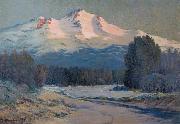 |
Ernst William Christmas
|
|
(1863-1918) was an Australian painter. He was born near Adelaide, South Australia in 1863 and studied art in Adelaide, Sydney and in London. He painted widely in England, exhibiting in the early years of the century at the Royal Academy, the Royal Institute of Oil Painters, the Royal Society of British Artists, the Royal Glasgow Institute of Fine Arts and in the provinces.
He was elected to the British Royal British Academy in 1909. In 1910-11, he painted mountains and lakes in Argentina and Chile. He lived in San Francisco around 1900 and again around 1915. He was an avid traveller, but spent the last two years of his life in Hawaii, where he painted landscapes including dramatic volcano scenes. Ernest William Christmas died in Honolulu in 1918.
|
|
|
|
|
|
|
|
|
|
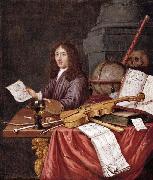 |
Evert Collier
|
|
(c. 1640 - few days before September 8, 1708) was a Dutch painter known for vanitas still-life and trompe l'oeil paintings. His first name is sometimes spelled "Edward" or "Edwaert" or "Eduwaert" or "Edwart," and his last name is sometimes spelled "Colyer" or "Kollier".
Evert Collier was born between 1630 and 1650 in Breda, Noord-Brabant, and died in 1708. He is believed to have trained in Haarlem, as his earliest paintings show the influence of Pieter Claesz and Vincent Laurensz van der Vinne. By 1667, he had moved to Leiden, where he became a member of the Guild of St. Luke in 1673. He moved to Amsterdam by 1686 and to London in 1693. He was buried September 8, 1708 at St. James's, Piccadilly. |
|
 |
Eyre Crowe
|
|
Sir Eyre Alexander Barby Wichart Crowe GCB GCMG (30 July 1864 - 28 April 1925) was a British diplomat. Crowe was appointed Companion of the Order of the Bath (CB) in 1907, Knight Commander of the Order of St Michael and St George (KCMG) in 1911, Knight Commander of the Order of the Bath (KCB) in 1917, Knight Grand Cross of the Order of St Michael and St George (GCMG) in the 1920 New Year Honours,[1] and Knight Grand Cross of the Order of the Bath (GCB) in the 1923 Birthday Honours.
Eyre Crowe was born in Leipzig and educated at Desseldorf and Berlin and in France, with a German mother and a German wife. His father Joseph Archer Crowe had been a British consul-general and ended his career as commercial attache for all of Europe (1882-1896). His grandfather Eyre Evans Crowe was a journalist, writer and historian, and his uncle, Eyre Crowe, was an artist.
Crowe first visited England in 1882 when he was seventeen to cram for the Foreign Office examination and at the time was not fully fluent in English.[2] Even later in life it was reported that when angry he spoke English with a German accent. He married his widowed German cousin Clema Gerhardt in 1903. Crowe's wife's uncle was Henning von Holzendorff, who was to become the Chief of the German Naval Staff in the First World War. Due to being half-German, Crowe was often attacked in the press and by Christabel Pankhurst and William le Queux for this during the First World War.
|
|
|
|
|
|
|
|
|
|
|
|
|
|
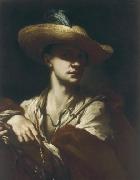 |
Francesco Caccianiga
|
|
Francesco Caccianiga (1700-1781) was an Italian painter and engraver.
He was born in Milan. In Bologna, he became a pupil of Marcantonio Franceschini. He afterwards visited Rome, where he established himself under the patronage of Prince Borghese, for whom he executed some considerable works in the Palazzo and the Villa Borghese. His principal works are at Ancona, where he painted several altar-pieces, among them, Marriage of the Virgin and Last Supper. |
|
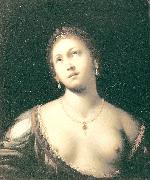 |
Francesco Cairo
|
|
(1607-1665) was an Italian painter active in Baroque Lombardy and Piedmont.
He was born and died in Milan. It is not known where he obtained his early training though he is strongly influenced by the circle of il Morazzone, in works such as the Saint Teresa altarpiece in the Certosa di Pavia.
In 1633, Cairo moved to Turin to work as a court painter, including portraits, to Vittorio Amedeo I of the House of Savoy. Between 1637-1638, Cairo travelled to Rome, where he encounters the works of Pietro da Cortona, Guido Reni and of the Caravaggisti. He returns to Lombardy to complete altarpieces for the Certosa of Pavia and a church at Casalpusterlengo. He painted a St. Theresa for San Carlo in Venice. Between 1646-1649, he returns to Turin, and paints an altarpiece for Savigliano and the church of San Salvario. He is also known as Il Cavaliere del Cairo, because in Turin, he received the order of SS. Lazarus and Maurice in recognition of his merit.
Many of his works are eccentric depictions of religious ecstasies; the saints appear liquefied and contorted by piety. He often caps them with exuberant, oriental turbans. |
|
|
|
 |
Francesco Cozza
|
|
1605-1682)was an Italian painter of the Baroque period.
He was born in Stilo in Calabria and died in Rome. As a young man, he went to Rome and apprenticed with Domenichino. He traveled with Domenichino to Naples.
He is best known for his expansive panegyric ceiling fresco, Apotheosis of Pamphili House, in the library of Palazzo Pamphili in Piazza Navona (1667-73). He also frescoed the Stanza del Fuoco in Palazzo Pamphili in Valmontone, 1658-59), where he worked along with Pier Francesco Mola, Gaspar Dughet, Mattia Preti, Giovanni Battista Tassi (il Cortonese), and Guglielmo Cortese. He also participated with Carlo Maratta and Domenico Maria Canuti in fresco decorations of the Palazzo Altieri. His landscape paintings recall the Carracci style of paesi con figure piccole (landscapes with small figures). He painted a Madonna del Riscatto in church of Santa Francesca Romana. He was received into the Accademia di San Luca at Rome in 1650. |
|
|
|
|
|
|
|
|
|
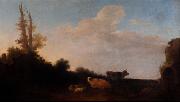 |
Francesco Giuseppe Casanova
|
|
(1727-1803) was an Italian painter and a younger brother of Giacomo Casanova.
Francesco Casanova Battaglia di cavalleria (oil on canvas, Louvre, Paris)Born in London, he trained in Venice under Francesco Guardi, then was a pupil of Francesco Simonini, a battle painter who took Borgognone as his model. Besides battle-pieces Casanova painted landscapes with figures and cattle, as well as pastoral subjects. He arrived in Paris in 1751, and went to Dresden in the following year, where he remained until 1757, spending his time in copying the finest battle-pieces of the famous Electoral Gallery. On his return to Paris he studied for a time under Charles Parrocel, and was received into the Academy in 1763. He exhibited at the Salon at intervals from that year till 1783, when he again quit France, going to Vienna, where he resided during the remainder of his life. Philip James de Loutherbourg was his pupil for a time.
|
|
|
|
|
|
|
|
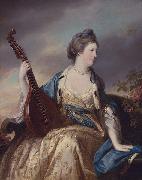 |
Francis Cotes
|
|
(20 May 1726 - 16 July 1770) was an English painter, one of the pioneers of English pastel painting, and a founder member of the Royal Academy in 1768.
He was born in London, the eldest son of Robert Cotes, an apothecary (Francis's younger brother Samuel Cotes (1734 - 1818) also became an artist, specialising in miniatures). Cotes trained with portrait painter George Knapton (1698 - 1778) before setting up his own business in his father's business premises in London's Cork Streetelearning, incidentally, much about chemistry to inform his making of pastels.
An admirer of the pastel drawings of Rosalba Carriera, Cotes concentrated on works in pastel and crayon (some of which became well-known as engravings). After pushing crayon to its limit as a mediumealthough he was never to abandon it entirelye - otes turned to oil painting as a means of developing his style in larger-scale works. In his most successful paintings, particularly those of the early 1760s, the oil paint is thinly applied, in imitation of his pastel technique, and imbued with charm, inviting comparisons with Allan Ramsay (1713 - 1784) and Sir Joshua Reynolds. They have clarity and warmth and possess a remarkable attention to costume. In 1763, he bought a large house (later occupied by George Romney) in Cavendish Square.
One of the most fashionable portrait painters of his day, Cotes helped found the Society of Artists and became its director in 1765. At the peak of his powers, Cotes was invited to become one of the first members of the Royal Academy, but died just two years later, aged 44, in Richmond.
He also taught pastel skills to John Russell, and his skills were described in book The Elements of Painting with Crayon.
|
|
|
|
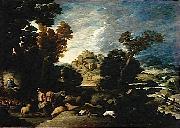 |
Francisco Collantes
|
|
(1599-1656) was a Spanish Baroque era painter.
Collantes was born in Madrid but sought influence from Jusepe de Ribera and the Neapolitan School. He was also influenced by 16th century Venetian painters and was renowned for his landscapes and biblical scenes. |
|
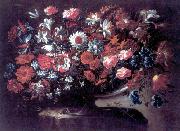 |
Francisco Lopez Caro
|
|
(1578-1662) was a Spanish painter of the Baroque period. Born in Seville, he was a pupil of Juan de las Roelas. We know very little of him, save that he painted with indifferent success in Seville until about 1660, when he went to Madrid where he spent the remainder of his life, and died in 1662. His works were mainly portraits, some of which are in private collections in Madrid, Salamanca, Granada, and Seville. |
|
|
|
|







